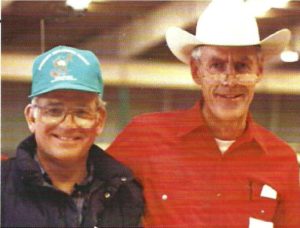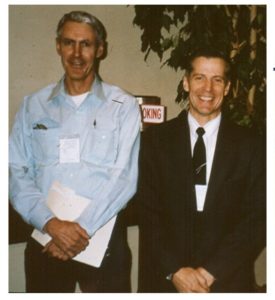35th Anniversary of Burney Chapman and George Platt’s AAEP Presentation

Dr. George Platt, DVM (left) and Burney Chapman, CJF (right) were pioneers in learning how to effectively treat horses with laminitis and founder. In 1984, they presented their findings at the AAEP meeting in Dallas, Texas. It was the first time a farrier had presented at this meeting. (Photo credit: Jeff Rodriguez, The Clinch Cutter, mid-1990s.)
This week is the 35th anniversary of the landmark AAEP (American Association of Equine Practitioners) meeting where Burney Chapman, CJF and Dr. George Platt, DVM presented their research on effectively treating laminitis and founder. Much of what they presented then is still what competent farriers today are using to save afflicted horses. There has been additional research and some improvements made to their initial findings, but Burney Chapman and George Platt’s original research is responsible for saving countless horses’ lives and helping farriers and veterinarians alike to understand this devastating disease.
The meeting, held December 1-5 in 1984, was significant because it was the first time a farrier had ever presented at the AAEP. Before that time, the AAEP (founded in 1954) was primarily driven by equine veterinarians and the annual meeting consisted largely of veterinarian presenters. In 1984, Burney Chapman and George Platt showed how important it is for farriers and veterinarians to work together for the benefit of the horse. Since that time, many farriers have presented at the AAEP proceedings.
Today, laminitis is still considered a big problem. According to an AAEP survey, 63% of veterinarians said that laminitis was the disease most in need of research (Equus, Jan 2010). According to a farrier survey, 84% of farriers claimed to deal with laminitis each month (American Farriers Journal, Sept 2011). Many farriers have followed Burney Chapman and George Platt’s treatment plan for horses with laminitis and founder and been successful.
The treatment plan that Chapman and Platt recommended consisted of properly applying a heart-bar shoe to transfer weight from the front half of the foot to the frog and stabilizing the rotated coffin bone within the hoof. They also recommended doing a dorsal hoof wall resection to relieve pressure from edema and abscesses. By creating a deep bed of straw in the stall, the horse would be encouraged to lie down and get its feet at the same level as its heart. Dr. Platt also strongly encouraged that there be no long-term pharmaceutical pain-relieving drugs prescribed as it would deceive the horse into thinking that nothing was wrong with the feet and the horse might do more damage to the compromised hoof/bone bond. Dr. Platt used to say, “the heart-bar shoe is my recommended pain medicine!”
The main principle of treatment for a horse with a laminitis or founder is to get a new hoof to grow and create a healthy, new reattachment between hoof and bone. This is similar to a human destroying the bond of the fingernail by accidentally smashing it with a hammer. The attachment of the nail is loose and painful, but a new fingernail will grow in time. The main difference is that the horse walks on its “fingernails” so it is critical to transfer weight (with a heart-bar shoe) to the frog pad of the foot (or to the pad of the fingertip in the analogy) while the new hoof grows.

Burney Chapman (left) and Doug Butler (right) in Switzerland at the World Veterinary Congress, 1993.
This week, in our podcast, we commemorate the 35th anniversary of Burney Chapman and George Platt’s presentation at the AAEP by remembering their research. Dr. Doug Butler summarizes their findings and also illustrates the treatment’s effectiveness with his own experiences and the experiences of other great farriers. Doug Butler was fortunate enough to enjoy close friendships with both of these great pioneers of the craft and he reflects on some personal experiences he had with them. This week, we honor the legacy of Burney Chapman and Dr. George Platt by remembering their long-lasting contributions to our noble craft.
You can listen to the podcast on iTunes (for iPhones) or Stitcher (for Android).
Related Posts
-
Each year around Valentine’s Day, we are reminded to t...Feb 15, 2012 / 0 comments
-
Foaling season is just around the corner. A question often a...Jan 22, 2013 / 0 comments
-
Horses require a great deal of care. Not only should they ha...Jun 21, 2018 / 0 comments
Blog Categories
- Anatomy
- Best Business Practices
- Conformation
- Current Events
- Customer Service
- Draft Horse Shoeing
- Equine Soundness
- Essential Anatomy Kit
- Farrier Careers
- Farrier training
- Foal soundness
- Horse Care
- Horse Foot Care
- Horse Owner Tips
- Horsemanship
- Horseshoeing
- Horseshoeing History
- Iron and Forge Work
- Student Spotlight
- Uncategorized
- Veterinary Care
Blog Archives
Contact Us
Butler Professional Horseshoeing School
495 Table Road
Crawford, NE 69339
(800) 728-3826
jacob@dougbutler.com
Subscribe to Our Blog
Get Our Free e-Book!
If you think you want to become a farrier (or know someone who does), this book can help you make that decision. Horse owners will learn the importance of choosing a qualified farrier and how to select the “right” one.
[ Get the e-Book Now! ]
- Follow:
